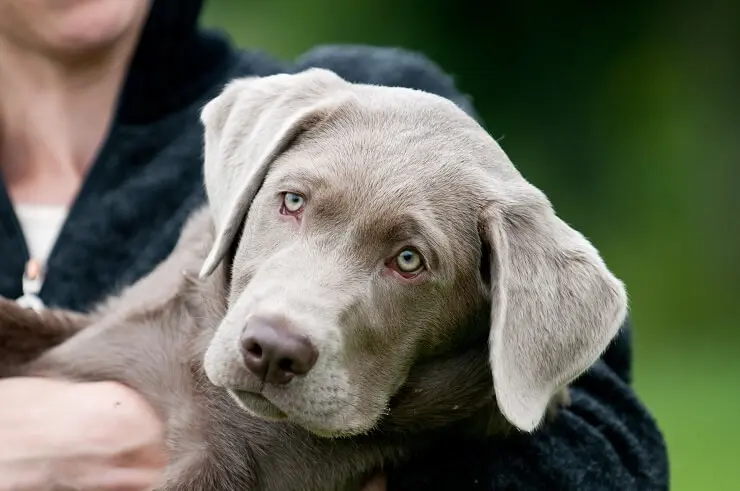Silver Labs are just like any other type of Labrador: loving, intelligent, and energetic! Of course, there is one big difference; they have a striking coat color.
Their silver-grey-blue coat means they stand out from the usual crowd of Labs.
The coat color is caused by two recessive genes that have only recently appeared in the Labrador gene pool. Their status as a pedigree is a hot debate. There are claims that Silver Labs are not purebred Labradors at all, but rather a crossbreed between a Labrador retriever and a Weimaraner.
No matter how you feel about the pedigree status of the breed, these dogs are beautiful and would make a lovely pet for anyone.
TABLE OF CONTENTS
What is a Silver Lab?

From Adobe Stock
Many people think that there are only three types of Labrador Retriever: black, yellow and chocolate. However, more color variations do exist. A Silver Labrador has a silver-grey-blue colored coat.
The American Kennel Club recognizes them as pedigree, but they are listed as Chocolate Labs (more on this later). Due to the controversy about their pedigree, they cannot be show dogs but they can be working dogs like their ancestors were bred to be.
Some people argue that they should not be described as a pedigree Labrador. Silver Labs came out of nowhere when they were first bred in the 1950s. This led to theories that Silver Labs were the result of outbreeding with Weimaraners. While there is no definitive proof that this is the case, it is a possibility to be aware of.
Labradors were originally bred to work, mainly as gun dogs. These days they are used for a wide variety of tasks including service animals, show dogs, gun dogs, obedience dogs and sniffer dogs.
Because they were bred to work, they are a high energy breed so will need an hour of exercise each day. They are not just limited to walking, once fully developed they can be great running pals!
Silver Lab Appearance

From Adobe Stock
Other than the color of their coat, the Silver Lab is the same as any other Labrador.
They are broad throughout their skull, chest and hind quarters, with floppy ears and a thick tail.
Their coat is short, dense, straight and hardy, with an eye-catching silver-grey-blue color that gives them their name. They have a double coat which means they shed quite a bit, especially during Spring and Fall.
Occasionally you will see the with blue eyes – this is very rare and very beautiful.
Height and Weight
As an adult you can expect them to weigh between 55-80lbs and be around 21 to 24 inches tall.
Females will be slightly smaller than males but not that noticeably. Labradors tend towards being slightly overweight, so make sure you keep a close eye open on their diet (more on this later).
Why Is It Silver?
The Silver Labs’ coat can vary between silver, grey and blue tones. This variation comes from the fact that their coat is a dilution of the usual chocolate color.
This color is caused by the appearance of two recessive genes rather than the usual dominant-dominant or dominant-recessive combinations. The recessive gene is called the ‘dilution gene’ because it dilutes the coat color of the dog.
For example, Chocolate Labs are usually a pure brown color. If a Chocolate Lab has two recessive genes, this dilutes the normally solid color into a lighter version. This produces a Silver Lab. Diluted Black Labs are called Charcoal Labradors and Yellow Labs are called Champagne Labradors.
Coat
Labrador coats are straight, dense and hardy. They have double coats which are great for keeping them warm in all weathers. They are also great in the water as the double coat helps to insulate them.
Silver Lab Temperament
Their temperament will be the same as any other Labrador. They are friendly, loving, playful and intelligent dogs.
You can expect them to be playful and love to interact with you, your family and friends. They can be very silly sometimes and will have everyone laughing at their antics.
The Silver Lab is not a particularly vocal breed but is known to bark if bored. If left with nothing to do, they will quickly become bored. The mischievous pup will quickly resort to finding their own ways to entertain themselves which will often involve chewing up things you probably don’t want chewed. Be sure to provide them with entertainment and do not leave them alone all day.
These dogs do not like being left for long working days and would much prefer to be with someone. They aren’t particular about who it is as they generally love everyone!
Doggy day care is a great option if you do have to be out of the house for an extended time. They will enjoy being around the other dogs and getting out and about.
They are excellent with all people, children included, as long as they are socialized properly from a young age. They don’t have issues with other dogs or other animals either.
Labradors are big eaters. They will manage to find food pretty much anywhere, so be sure to put food well out of their reach!
Altogether these dogs are just fantastic. They are full of love and affection for absolutely everyone and will be a joy to have around the house.
Is A Silver Lab A Good Family Dog?
Silver Labs, like any other Labrador, are wonderful and rewarding family pets. They are very patient with children of all ages if they are socialized from a young age.
How to Train

From Adobe Stock
The best way to train not just Labs, but any dog, is through positive reinforcement. This means the correct behavior is rewarded with treats, toys or affection. Their favorite reward will be treats because of their huge appetite.
Labradors are highly intelligent, so they will really enjoy their dog training sessions. Consistency and repetition are the most important elements for any successful training.
Due to their high levels of intelligence, they can get bored quite easily. Training them provides them with lots of mental stimulation to keep them occupied.
In addition to treat rewards you can use toys, especially ones that are good for chewing.
A good game to keep your dog occupied is fetch. This can be played on walks in secure areas or in back gardens. It allows them to burn off lots of energy with minimal work from you. If your dog is off leash, make sure they have good recall to avoid any difficult situations.
Labradors are naturally friendly dogs. They adore being around humans so be sure to introduce them to lots of people when they are young. Socialization with other dogs is also important. Puppy parties are a great way of socializing any young dogs.
Caring for a Silver Lab

From Adobe Stock
Labradors need a fair amount of care but it’s all worth it for these loving pooches.
They will need around an hour of exercise each day. This can be in the form of two half hour walks or a variety of other activities. They also need regular training sessions, especially when they are young. Time to socialize with other dogs is important as well (dog parks are perfect for this).
Their grooming requirements are quite simple. They need brushing twice a week to keep their coat healthy. These dogs are best suited to an individual or family that has a fenced back yard and plenty of time to spend playing, exercising and cuddling them.
Labs need all the usual care such as regular nail clipping, worming and flea treatments. They also will need their teeth cleaned regularly.
This can be done with a finger toothbrush or with dental chews which have been shown to be just as good.
Labs also love to swim which can make them prone to ear infections, so be sure to keep their ears clean.
Exercise Requirements
Labradors are high energy dogs which means they will need around an hour of walking a day, preferably in two sessions.
Having a fenced backyard will also be a big benefit, as it means they will have space to play outside all the time. These dogs would not do well in an apartment.
They are very intelligent so training them with recall should be easy. This means that you can walk them off leash. This is perfect for Labradors as they love to run and explore new places.
What Labradors love most is water.
Any body of water is great for the Lab and mud is just an added benefit!
They will enjoy any type of exercise you want to do with them. Whether it’s going on runs or doing agility training, your Lab will be a great fitness partner.
Grooming and Shedding
Silver Labs shed a fair amount all year round thanks to their double coat. This is especially true in Spring and Fall (the shedding seasons).
This means they will need regular brushing at least twice a week to maintain a healthy coat, possibly more during the shedding seasons. Investing in a good quality shedding brush and vacuum cleaner will definitely be needed with these dogs.
It will benefit your dog to be professionally groomed occasionally as well. This keeps their skin healthy and reduces shedding. There are no specific coat cuts for Labradors, but it is generally kept short all over.
Feeding and Diet
Labradors are medium size dogs so they will need to be fed around one and a quarter cups of high-quality, dry dog food twice a day.
This can be mixed with a high-quality wet food as well to form a balanced diet.
When buying dog food, it’s important that the food is high in protein as 25% of a dog’s diet should consist of protein. Ideally, you should also avoid foods that contain dyes, rendered fats and corn or wheat gluten.
Remember though, they are prone to obesity so try not to give them too many snacks.
Known Health Problems
Silver Labs will suffer from the same health issues experienced by other Labs. These are hip and elbow dysplasia and eye problems. If you are getting a puppy from a breeder you should always ask for their hip and elbow scores.
You should also get an eye check as well. On balance, Labradors are usually quite healthy dogs.
Also, due to their unusual coat, can be prone to a specific type of alopecia called color dilution alopecia. This is not fatal, but it does mean their fur may fall out in patches when they are young. They could also have reoccurring infections in their hair follicles.
How Long Do Silver Labs Live?
A healthy Silver Labs will live around 10-14 years.
Buyer’s Guide

From Adobe Stock
Whenever you are buying a puppy, the most important thing you can do is look for a reputable breeder. This is someone who breeds responsibly and has a history of healthy, well documented puppies.
As they are quite a rare breed, this may be quite a difficult task, but it is possible.
There are breeders who have Silver Lab puppies that are fully health checked. You may, however, be put on a waiting list as this bred is growing in popularity.
When you meet the puppies, be sure that you can interact with the parents or at least the mother. This will help you see what temperament and personality the puppies may have inherited.
As the Silver Lab is certified by the American Kennel Club, be sure to ask for documentation from the breeder. Remember, they will be listed as Chocolate Labs.
A good breeder will ask you lots of questions about your home life to get a good idea of where their puppies will be going. Be sure to ask lots of questions yourself as the breeder will be a great source of information regarding the individual puppies and their overall care.
How Much Do Silver Lab Puppies Cost?
They are quite a rare breed, and because of this they are quite expensive. Buying a Silver Lab puppy will cost you around $1,200.
Be sure not to be buy cheaper puppies as you are likely supporting bad breeding or puppy mills. You may also not be getting a true pedigree Lab.
Quick Breed Summary Table
| Breed Characteristics | |
| Size: | 21 to 24 inches |
| Weight: | 55-80lbs |
| Lifespan: | 10-14 years |
| Coat: | Medium length, straight, dense, and double coat |
| Color: | Silver-grey-blue |
| Do They Shed: | Yes, they have a double coat so shed all year round but more in Spring and Fall |
| Temperament: | Extremely friendly, loving, playful and energetic |
| Intelligence: | Very intelligent and trainable |
| Socialization: | Great with other dogs and other pets |
| Destructive Behavior: | Prone to chewing if bored |
| People Skills: | Loves everyone |
| Good with Children: | Great with children and very patient |
| Activity Levels: | High activity levels, need at least an hour of exercise every day |
Summary
The Silver Labrador is best suited to any individual or family that has the time, space and energy to give this gorgeous pup everything it deserves. They do like to have someone around a lot of the time but aren’t fussy who it is.
They are super friendly, loving dogs with plenty of energy which means there’s lots of fun to be had!
Generally, they have no issues with other dogs or any other animals.
Labs do require a fair amount of exercise and mental stimulation to keep them out of mischief; at least an hour a day. Their grooming and care are simple if you keep on top of their shedding.
Overall the Silver Lab is a fabulous, eye-catching dog that will remain a loving companion to you for many years.









Thank you for posting this article on the Silver Lab. This clearly explains how the color came to be. I have a chocolate Lab, his grandfather is a silver Lab. His sire was imported from England. Anyway your article explains to me why why his hair looks the way it does. I bought him at 8 weeks old as a chocolate Lab he was Brown everywhere. At 5 months his tail lost some of the brown so he has a spot that is silver and yellow. Now he is 17 months old and except for the spot on his tail he looks like a chocolate Lab but on close examination his outer coat the hairs are a light silver and top half are brown. His under coat is brown. He is a purebred as I have registered with the AKC.
I have a Silver lab that’s now 6 years old. She looks like a carbon copy of her sister who is 10 and a chocolate lab. They are both from different litters. I don’t understand how people can say a silver is not a lab. Mine is, and that’s all that matters to me.
Good afternoon Yolanda! Sorry to bother you, but I am looking into getting a Silver Labrador but am skeptical of the Color Dilute Alopecia forming, I feel that people are speaking about this as a possibility of happening but not a frequent occurrence. Have you experienced any type of Alopecia or skin issue with your Labrador being that he/she is 6 years old? Thank you for your time!
My silver lab is 20 months old .he fits your description and traits to the letter . His face is extremely silver but sometimes in the right lighting a tinge of light brown comes through on his body. He is my joy!
I have a silver lab puppy that I would like to breed to a black labradoodle. What would be my chances of getting silver labradoodle puppies!! My silver lab email daddy is the silver lab in the mama is a chocolate lab
I think the puppies would be black because black is the dominant gene and all Labradors carry it
My wife and I just brought our 8 week old silver lab home Friday morning. He is easily trained and highly intelligent. We know the breeders personally and the parents are both silver labs… this little guy is pure silver lab through and through.
Sage is my Silver lab he is smart ambitious and playful I am fortunate to have this amazing dog!
I plan on learning to pheasant hunt.
We will learn together.